压力与健康stress-and-health讲课讲稿
压力与健康讲课版
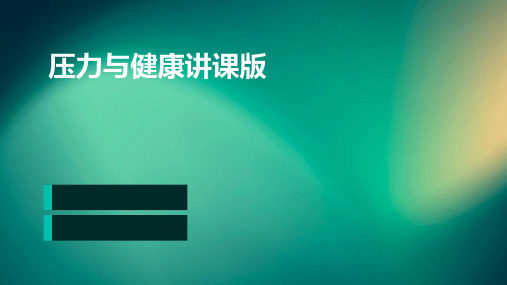
精神压力
精神压力是指由于心理因素所 造成的心理负担,如情绪波动、 心理冲突等。
精神压力可能引发焦虑、抑郁、 强迫症等症状,长期积累会对 心理健康造成影响。
应对精神压力的方法包括心理 咨询、心理治疗、放松训练等。
02 压力对健康的影响
生理影响
01
02
03
心血管系统
长期压力可能导致血压升 高、心率加快,增加心脏 病和高血压的风险。
社会影响
人际关系
长期压力可能影响人的社交和人 际关系,导致孤独感和社交障碍。
工作效率
压力可能影响工作效率和创造力, 使人难以集中注意力。
家庭生活
压力可能影响家庭生活的质量,导 致家庭矛盾和冲突。
03 如何应对压力
调整心态
积极面对
遇到压力时,应保持乐观积极的 心态,相信自己能够克服困难。
接受自己
消化系统
压力可能导致胃部不适、 腹泻、便秘等症状,影响 消化功能。
免疫系统
压力会削弱免疫系统的功 能,使人更容易受到病毒 和细菌的侵害。
心理影响
焦虑和抑郁
长期压力可能导致焦虑和 抑郁情绪,影响心理健康。
睡眠障碍
压力可能导致失眠、睡眠 质量差等问题,影响睡眠 质量。
情绪稳定性
压力可能影响情绪的稳定 性,使人更容易发脾气或 情绪低落。
工作压力可能来自于工作量过大、工 作要求过高、时间紧迫等,长期处于 工作压力下会对身心健康造成负面影 响。
生活压力
生活压力是指在生活中由于各种 事件所造成的心理负担,如家庭 问题、经济困难、人际关系等。
生活压力可能引发焦虑、抑郁、 失眠等症状,长期积累会对身体
健康造成影响。
应对生活压力的方法包括调整心 态、寻求帮助、培养兴趣爱好等。
压力与健康
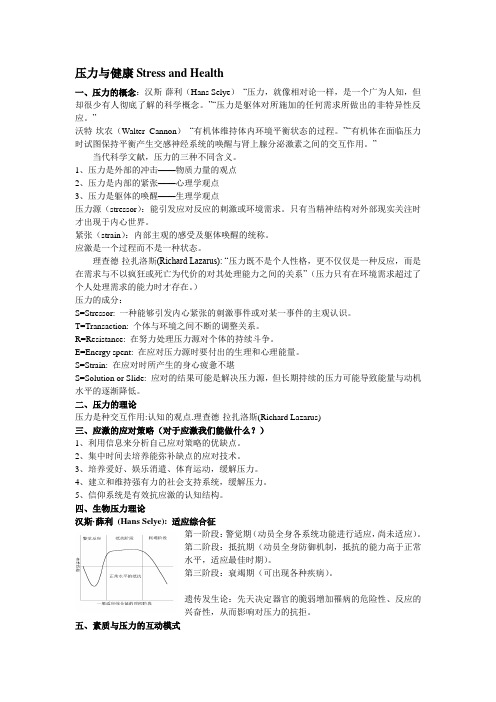
压力与健康Stress and Health一、压力的概念:汉斯·薛利(Hans Selye)“压力,就像相对论一样,是一个广为人知,但却很少有人彻底了解的科学概念。
”“压力是躯体对所施加的任何需求所做出的非特异性反应。
”沃特·坎农(Walter Cannon)“有机体维持体内环境平衡状态的过程。
”“有机体在面临压力时试图保持平衡产生交感神经系统的唤醒与肾上腺分泌激素之间的交互作用。
”当代科学文献,压力的三种不同含义。
1、压力是外部的冲击——物质力量的观点2、压力是内部的紧张——心理学观点3、压力是躯体的唤醒——生理学观点压力源(stressor):能引发应对反应的刺激或环境需求。
只有当精神结构对外部现实关注时才出现于内心世界。
紧张(strain):内部主观的感受及躯体唤醒的统称。
应激是一个过程而不是一种状态。
理查德·拉扎洛斯(Richard Lazarus): “压力既不是个人性格,更不仅仅是一种反应,而是在需求与不以疯狂或死亡为代价的对其处理能力之间的关系”(压力只有在环境需求超过了个人处理需求的能力时才存在。
)压力的成分:S=Stressor: 一种能够引发内心紧张的刺激事件或对某一事件的主观认识。
T=Transaction: 个体与环境之间不断的调整关系。
R=Resistance: 在努力处理压力源对个体的持续斗争。
E=Energy spent: 在应对压力源时要付出的生理和心理能量。
S=Strain: 在应对时所产生的身心疲惫不堪S=Solution or Slide: 应对的结果可能是解决压力源,但长期持续的压力可能导致能量与动机水平的逐渐降低。
二、压力的理论压力是种交互作用:认知的观点.理查德·拉扎洛斯(Richard Lazarus)三、应激的应对策略(对于应激我们能做什么?)1、利用信息来分析自己应对策略的优缺点。
2、集中时间去培养能弥补缺点的应对技术。
Unit 7 Stress and Health 压力与健康
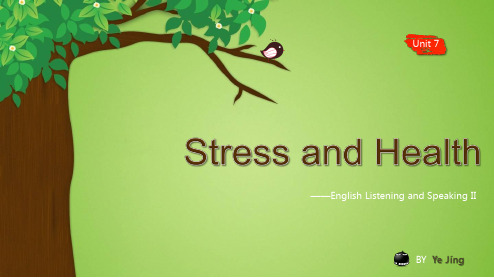
[əˌroʊmə'θerəpi]
Drink herbal tea
['ɜːrbl]
Get a massage
[mə'sɑːʒ]
8 of 32
Part I Warming up
Part I
Part II
Warming up
Listening Tasks
Part III
Part IV
Your turn to talk
1. Why don’t you ______________, take a vacation you know, just a few days off from work? join a gym You know, take an _________ aerobics class or something. Maybe you should ___________. Yoga is a great way to deal with stress, and it would probably help you sleep at night. _____ aromatherapy The article said some Well, like yoga, and exercise, and – oh, yeah – ____________! smells can be very relaxing. going out How about __________with me this Friday? It’ll do you good. We could go out to ____, eat then maybe see a movie.
压力与健康
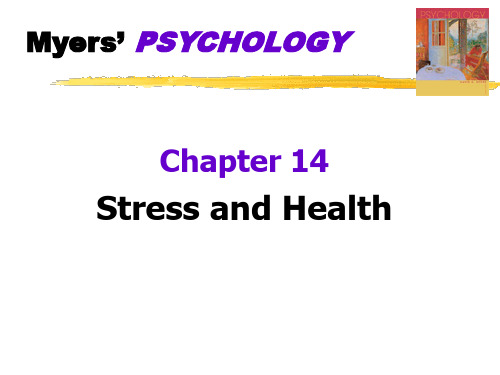
Release of stress hormones
Immune suppression
Autonomic nervous system effects
(headaches, hypertension)
Promoting Health
Depression 14 score 13
No-treatment group
Phase 2 Resistance (cope with stressor)
Phase 3 Exhaustion (reserves depleted)
▪ General Adaptation Syndrome
▪ Selye’s concept of the body’s adaptive response to stress in three stages
▪ Social support across the life span
Percentage with high support 100%
90
80
70
60
50
12-14
18-19
25-34
45-54
65-74
15-17
20-24
35-44
55-64
75+
Age in years
Life events
Moderate risk
High risk
Stress and the Heart
▪ Type A
▪ Friedman and Rosenman’s term for competitive, hard-driving, impatient, verbally aggressive, and anger-prone people
缓解心灵压力健康走向未来发言稿
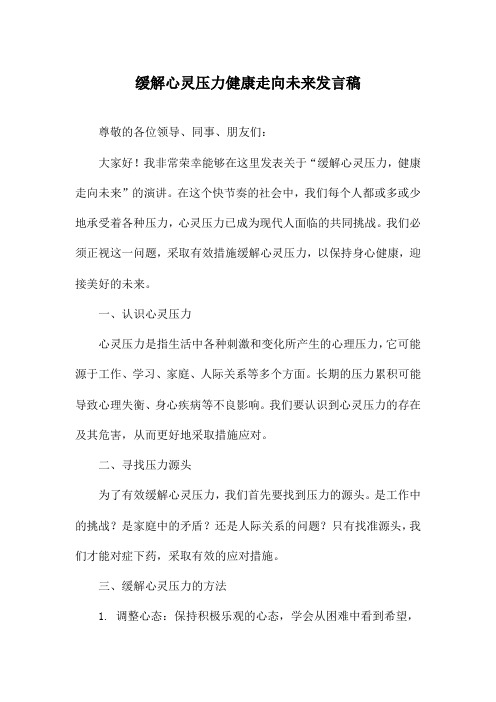
缓解心灵压力健康走向未来发言稿尊敬的各位领导、同事、朋友们:大家好!我非常荣幸能够在这里发表关于“缓解心灵压力,健康走向未来”的演讲。
在这个快节奏的社会中,我们每个人都或多或少地承受着各种压力,心灵压力已成为现代人面临的共同挑战。
我们必须正视这一问题,采取有效措施缓解心灵压力,以保持身心健康,迎接美好的未来。
一、认识心灵压力心灵压力是指生活中各种刺激和变化所产生的心理压力,它可能源于工作、学习、家庭、人际关系等多个方面。
长期的压力累积可能导致心理失衡、身心疾病等不良影响。
我们要认识到心灵压力的存在及其危害,从而更好地采取措施应对。
二、寻找压力源头为了有效缓解心灵压力,我们首先要找到压力的源头。
是工作中的挑战?是家庭中的矛盾?还是人际关系的问题?只有找准源头,我们才能对症下药,采取有效的应对措施。
三、缓解心灵压力的方法1. 调整心态:保持积极乐观的心态,学会从困难中看到希望,从失败中汲取经验。
2. 锻炼身体:适当的运动能够释放压力,提高身体素质,增强抵抗力。
3. 沟通交流:与亲朋好友、同事领导沟通交流,减轻负担。
4. 放松心情:学会放松自己,通过听音乐、阅读、旅行等方式陶冶情操,舒缓压力。
5. 寻求帮助:当压力过大时,不妨寻求专业的心理辅导或咨询,及时解决问题。
四、培养健康的生活方式除了缓解压力外,我们还要培养健康的生活方式,以预防压力的产生。
这包括保持良好的饮食习惯、充足的睡眠、规律的生活作息、良好的人际关系等。
只有身心健康,我们才能更好地面对未来的挑战。
五、积极参与社会活动参与社会活动是缓解心灵压力的有效途径,我们可以参加志愿者活动、社区建设、文体活动等,通过与他人互动,增进友谊,提升自我价值感,从而减轻压力。
六、共同努力,共创美好未来让我们共同努力,从个人做起,从点滴做起,缓解心灵压力,培养健康的生活方式。
我们要相信自己,勇敢面对挑战,迎接美好的未来。
让我们携手共进,共同创造一个更加美好的明天!谢谢大家!缓解心灵压力健康走向未来发言稿(1)尊敬的各位领导、亲爱的同事们:大家好!我非常荣幸能够站在这里,与大家分享关于缓解心灵压力、健康走向未来的一些想法。
TED stress and healthy演讲稿
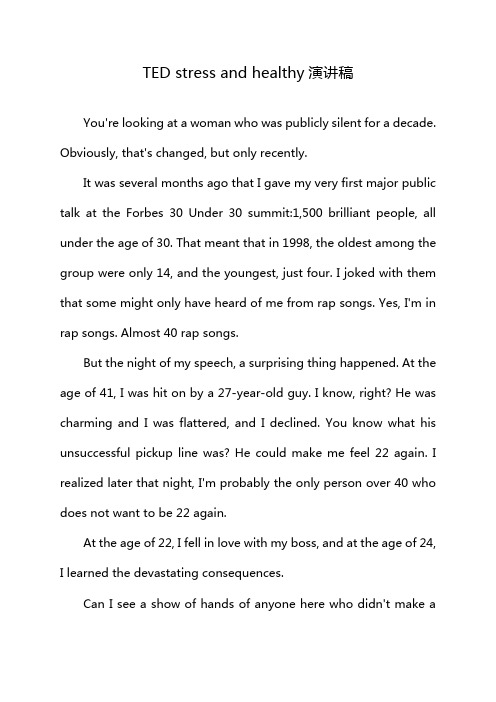
TED stress and healthy演讲稿You're looking at a woman who was publicly silent for a decade. Obviously, that's changed, but only recently.It was several months ago that I gave my very first major public talk at the Forbes 30 Under 30 summit:1,500 brilliant people, all under the age of 30. That meant that in 1998, the oldest among the group were only 14, and the youngest, just four. I joked with them that some might only have heard of me from rap songs. Yes, I'm in rap songs. Almost 40 rap songs.But the night of my speech, a surprising thing happened. At the age of 41, I was hit on by a 27-year-old guy. I know, right? He was charming and I was flattered, and I declined. You know what his unsuccessful pickup line was? He could make me feel 22 again. I realized later that night, I'm probably the only person over 40 who does not want to be 22 again.At the age of 22, I fell in love with my boss, and at the age of 24, I learned the devastating consequences.Can I see a show of hands of anyone here who didn't make amistake or do something they regretted at 22? Yep. That's what I thought. So like me, at 22, a few of you may have also taken wrong turns and fallen in love with the wrong person, maybe even your boss. Unlike me, though, your boss probably wasn't the president of the United States of America. Of course, life is full of surprises.Not a day goes by that I'm not reminded of my mistake, and I regret that mistake deeply.In 1998, after having been swept up into an improbable romance, I was then swept up into the eye of a political, legal and media maelstrom like we had never seen before. Remember, just a few years earlier,news was consumed from just three places: reading a newspaper or magazine, listening to the radio, or watching television. That was it. But that wasn't my fate. Instead, this scandal was brought to you by the digital revolution. That meant we could access all the information we wanted, when we wanted it, anytime, anywhere, and when the story broke in January 1998, it broke online. It was the first time the traditional news was usurped by the Internet for a major news story, a click that reverberated around the world.What that meant for me personally was that overnight I wentfrom being a completely private figure to a publicly humiliated one worldwide. I was patient zero of losing a personal reputation on a global scale almost instantaneously.This rush to judgment, enabled by technology, led to mobs of virtual stone-throwers. Granted, it was before social media, but people could still comment online, email stories, and, of course, email cruel jokes. News sources plastered photos of me all over to sell newspapers, banner ads online, and to keep people tuned to the TV. Do you recall a particular image of me, say, wearing a beret?Now, I admit I made mistakes, especially wearing that beret. But the attention and judgment that I received, not the story, but that I personally received, was unprecedented. I was branded as a tramp, tart, slut, whore, bimbo, and, of course, that woman. I was seen by many but actually known by few. And I get it: it was easy to forget that that woman was dimensional, had a soul, and was once unbroken.When this happened to me 17 years ago, there was no name for it. Now we call it cyberbullying(网络欺凌)andonline harassment(网络骚扰). Today, I want to share some of my experience with you, talkabout how that experience has helped shape my cultural observations, and how I hope my past experience can lead to a change that results in less suffering for others.In 1998, I lost my reputation and my dignity. I lost almost everything, and I almost lost my life.Let me paint a picture for you. It is September of 1998. I'm sitting in a windowless office room inside the Office of the Independent Counsel underneath humming fluorescent lights. I'm listening to the sound of my voice, my voice on surreptitiously taped phone calls that a supposed friend had made the year before. I'm here because I've been legally required to personally authenticate all 20 hours of taped conversation. For the past eight months, the mysterious content of these tapes has hung like the Sword of Damocles over my head. I mean, who can remember what they said a year ago? Scared and mortified, I listen, listen as I prattle on about the flotsam and jetsam of the day; listen as I confess my love for the president, and, of course, my heartbreak; listen to my sometimes catty, sometimes churlish, sometimes silly self being cruel, unforgiving, uncouth; listen, deeply, deeply ashamed, to the worstversion of myself,a self I don't even recognize.A few days later, the Starr Report is released to Congress, and all of those tapes and trans, those stolen words, form a part of it. That people can read the trans is horrific enough, but a few weeks later, the audio tapes are aired on TV, and significant portions made available online. The public humiliation was excruciating. Life was almost unbearable.This was not something that happened with regularity back then in 1998, and by this, I mean the stealing of people's private words, actions, conversations or photos, and then making them public -- public without consent, public without context, and public without compassion.Fast forward 12 years to 2010, and now social media has been born. The landscape has sadly become much more populated with instances like mine, whether or not someone actually make a mistake, and now it's for both public and private people. The consequences for some have become dire, very dire.I was on the phone with my mom in September of 2010, and we were talking about the news of a young college freshman fromRutgers University named Tyler Clementi. Sweet, sensitive, creative Tyler was secretly webcammed by his roommate while being intimate with another man. When the online world learned of this incident, the ridicule and cyberbullying ignited. A few days later, Tyler jumped from the George Washington Bridge to his death. He was 18.My mom was beside herself about what happened to Tyler and his family, and she was gutted with painin a way that I just couldn't quite understand, and then eventually I realized she was reliving 1998, reliving a time when she sat by my bed every night, reliving a time when she made me shower with the bathroom door open, and reliving a time when both of my parents feared that I would be humiliated to death,literally.Today, too many parents haven't had the chance to step in and rescue their loved ones. Too many have learned of their child's suffering and humiliation after it was too late. Tyler's tragic, senseless death was a turning point for me. It served to recontextualize my experiences, and I then began to look at the world of humiliation and bullying around me and see somethingdifferent. In 1998, we had no way of knowing where this brave new technology called the Internet would take us. Since then, it has connected people in unimaginable ways, joining lost siblings, saving lives, launching revolutions, but the darkness, cyberbullying, and slut-shaming that I experienced had mushroomed. Every day online, people, especially young people who are not developmentally equipped to handle this, are so abused and humiliated that they can't imagine living to the next day, and some, tragically, don't, and there's nothing virtual about that. ChildLine, a U.K. nonprofit that's focused on helping young people on various issues,released a staggering statistic late last year: From 2012 to 2013, there was an 87 percent increase in calls and emails related to cyberbullying. A meta-analysis done out of the Netherlands showed that for the first time, cyberbullying was leading to suicidal ideations more significantly than offline bullying. And you know what shocked me, although it shouldn't have, was other research last year that determined humiliation was a more intensely felt emotion than either happiness or even anger.Cruelty to others is nothing new, but online, technologicallyenhanced shaming is amplified, uncontained, and permanently accessible. The echo of embarrassment used to extend only as far as your family, village, school or community, but now it's the online community too. Millions of people, often anonymously, can stab you with their words, and that's a lot of pain, and there are no perimeters around how many people can publicly observe you and put you in a public stockade. There is a very personal price to public humiliation, and the growth of the Internet has jacked up that price.For nearly two decades now, we have slowly been sowing the seeds of shame and public humiliation in our cultural soil, both on- and offline. Gossip websites, paparazzi, reality programming, politics, news outlets and sometimes hackers all traffic in shame. It's led to desensitization and a permissive environment online which lends itself to trolling, invasion of privacy, and cyberbullying. This shift has created what Professor Nicolaus Mills calls a culture of humiliation. Consider a few prominent examples just from the past six months alone. Snapchat, the service which is used mainly by younger generationsand claims that its messages only have the lifespan of a few seconds. You can imagine the range of content thatthat gets. A third-party app which Snapchatters use to preserve the lifespan of the messages was hacked, and 100,000 personal conversations, photos, and videos were leaked online to now have a lifespan of forever. Jennifer Lawrence and several other actors had their iCloud accounts hacked, and private, intimate, nude photos were plastered across the Internet without their permission.One gossip website had over five million hits for this one story. And what about the Sony Pictures cyberhacking? The documents which received the most attention were private emails that had maximum public embarrassment value.But in this culture of humiliation, there is another kind of price tag attached to public shaming. The price does not measure the cost to the victim, which Tyler and too many others, notably women, minorities,and members of the LGBTQ community have paid, but the price measures the profit of those who prey on them. This invasion of others is a raw material, efficiently and ruthlessly mined, packaged and sold at a profit. A marketplace has emerged where public humiliation is a commodity and shame is an industry.How is the money made? Clicks. The more shame, the more clicks. The moreclicks, the more advertising dollars. We're in a dangerous cycle. The more we click on this kind of gossip, the more numb we get to the human lives behind it, and the more numb we get, the more we click. All the while, someone is making money off of the back of someone else's suffering. With every click, we make a choice. The more we saturate our culture with public shaming, the more accepted it is, the more we will see behavior like cyberbullying, trolling, some forms of hacking, and online harassment. Why? Because they all have humiliation at their cores. This behavior is a symptom of the culture we've created. Just think about it.Changing behavior begins with evolving beliefs. We've seen that to be true with racism, homophobia, and plenty of other biases, today and in the past. As we've changed beliefs about same-sex marriage, more people have been offered equal freedoms. When we began valuing sustainability, more people began to recycle. So as far as our culture of humiliation goes, what we need is a cultural revolution. Public shaming as a blood sport has to stop, and it's time for an intervention on the Internet and in our culture.The shift begins with something simple, but it's not easy. Weneed to return to a long-held value of compassion -- compassion and empathy. Online, we've got a compassion deficit, an empathy crisis.Researcher Brené Brown said, and I quote, "Shame can't survive empathy." Shame cannot survive empathy. I've seen some very dark days in my life, and it was the compassion and empathy from my family, friends, professionals, and sometimes even strangers that saved me. Even empathy from one person can make a difference. The theory of minority influence, proposed by social psychologist Serge Moscovici, says that even in small numbers, when there's consistency over time, change can happen. In the online world, we can foster minority influence by becoming upstanders. To become an upstander means instead of bystander apathy, we can post a positive comment for someone or report a bullying situation. Trust me, compassionate comments help abate the negativity. We can also counteract the culture by supporting organizations that deal with these kinds of issues, like the Tyler Clementi Foundation in the U.S., In the U.K., there's Anti-Bullying Pro, and in Australia, there's Project Rockit.We talk a lot about our right to freedom of expression, but we need to talk more about our responsibility to freedom of expression. We all want to be heard, but let's acknowledge the difference between speaking up with intention and speaking up for attention. The Internet is the superhighway for the id, but online, showing empathy to others benefits us all and helps create a safer and better world. We need to communicate online with compassion, consume news with compassion, and click with compassion. Just imagine walking a mile in someone else's headline. I'd like to end on a personal note. In the past nine months, the question I've been asked the most is why. Why now? Why was I sticking my head above the parapet? You can read between the lines in those questions, and the answer has nothing to do with politics.The top note answer was and is because it's time: time to stop tip-toeing around my past; time to stop living a life of opprobrium; and time to take back my narrative. It's also not just about saving myself. Anyone who is suffering from shame and public humiliation needs to know one thing: You can survive it. I know it's hard. It may not be painless, quick or easy, but you can insist on a differentending to your story. Have compassion for yourself. We all deserve compassion, and to live both online and off in a more compassionate world.Thank you for listening.。
压力与健康
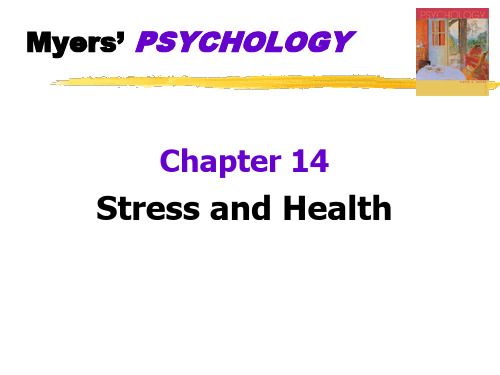
Moderate risk
High risk
Stress and the Heart
Type A
Friedman and Rosenman’s term for competitive, hard-driving, impatient, verbally aggressive, and anger-prone people
Aerobic Exercise
12
11
10
Relaxation
9
treatment
group 8
Aerobic
7 exercise
group 6
sustained exercise that increases heart and lung fitness
5
4
3 Before treatment evaluation
rush hour traffic, long lines, job stress, burnout
Stressful Life Events
Chronic Stress by Age
Perceived Control
Health consequences of a loss of control
some forms of hypertension some headaches
distinct from hypochondriasis-misinterpreting normal physical sensations as symptoms of a disease
Stress and Disease
The religion factor is mulitidimensional
压力与健康
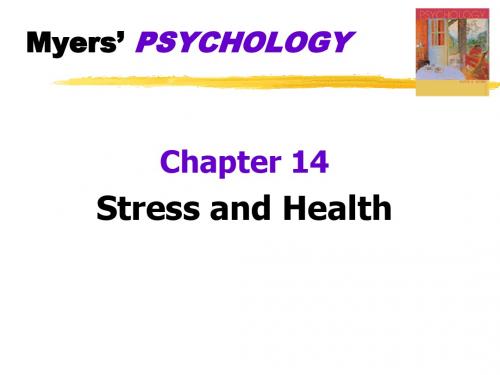
Negative emotions and health-related consequences
Heart disease
Persistent stressors and negative emotions
Unhealthy behaviors
(smoking, drinking, poor nutrition and sleep)
Myers’ PSYCHOLOGY
Chapter 14
Stress and Health
Stress and Health
Behavioral Medicine
interdisciplinary field that integrates behavioral and medical knowledge and applies that knowledge to health and disease
Social support across the life span
Percentage with high support 100%
90
80
70
60
50
12-14
18-19
25-34
45-54
65-74
15-17
20-24
35-44
55-64
75+
Age in years
Life events
Stress Appraisal
Stressful event (tough math test)
Appraisal
Threat (“Yikes! This is beyond me!”)
Challenge (“I’ve got to apply
第八压力与健康演示文稿
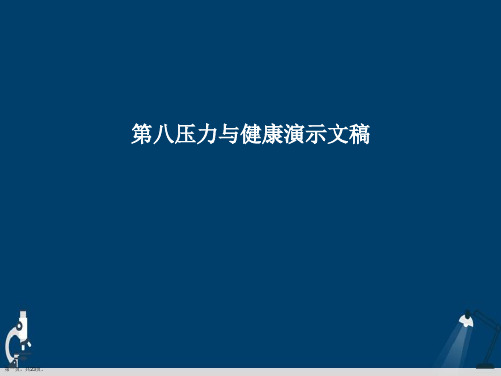
第二十一页,共23页。
为你的健康干杯
❖ 结交一些密友,你可以同他们分享感受、快乐和忧 虑。致力于发展、保持和拓展你的社会支持网络。
❖ 发展一种平衡时间的观点,从而可以灵活的对待你 的工作、环境的要求和自身的需求。有工作在手时 请面向未来,目标达到、有快乐在握时请珍惜现在 ,和你老友联系时请珍惜过去。
❖ 不可预测性。个体从一个情景到另一个情景的行为 都是不可预测和无规律的,好像有一种不能控制行 为的体验。一个孩子无缘无故打碎玻璃就是表现出 不可预测性。
第十七页,共23页。
❖ 非惯常性和统计的极端性。个体的行为方式在统计 学上处于极端位置且违反了社会认可克教授和赞许 性的标准。但是只有统计上的不寻常不能导致变态 的心理判断。
大学生压力时间量表的意义
❖ 学生压力量表示Holmes和Rahe的社会再适应量表 的修订,针对每个事件都给出一个分值,用以表征 一个人面对这种生活上的改变时所需要的再适应的 总量。分数等于或高于300的人存在健康风险。分数 在150到300之间的人在两年内有一半的几率发生严 重的健康问题。得分低于150的人有三分之一的机会 健康恶化。
第七页,共23页。
压力下的防御机制
第八页,共23页。
大学生压力事件量表
事件
生活变化单位 你的男友或女友
38
亲密家庭成员的死亡
100
学校工作的负担加重
37
亲密朋友的死亡
73
出众的个人成就
36
父母离异
65
在大学的第一学期
35
服刑
